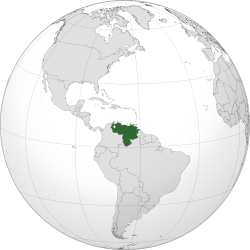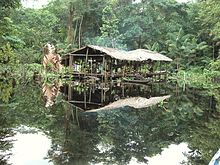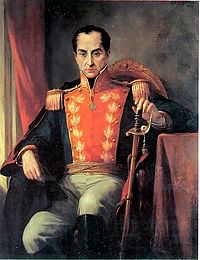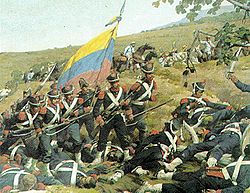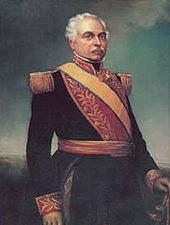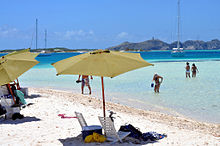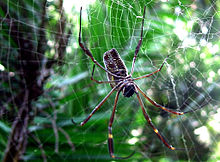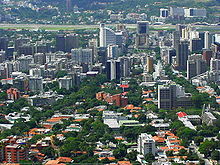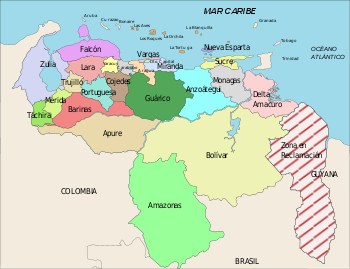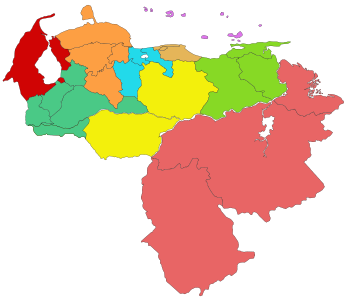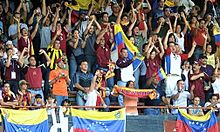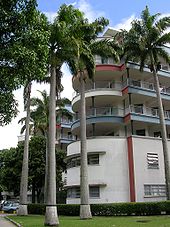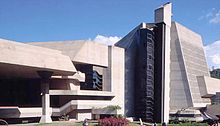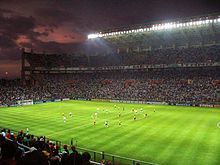- Venezuela
-
For other uses, see Venezuela (disambiguation).
Bolivarian Republic of Venezuela[1] República Bolivariana de Venezuela (Spanish)

Flag Coat of arms Motto: Historic: Dios y Federación (Spanish)
"God and Federation"Anthem: Gloria al Bravo Pueblo (Spanish)
Glory to the Brave PeopleVenezuelaCapital
(and largest city)Caracas
10°30′N 66°58′W / 10.5°N 66.967°WOfficial language(s) Spanish[2] National language Spanish[2] Demonym Venezuelan Government Federal presidential republic - President Hugo Chávez Frías - Vice President Elías Jaua Independence - from Spain 5 July 1811 - from Gran Colombia 13 January 1830 - Recognized 30 March 1845 - Current constitution 20 December 1999 Area - Total 916,445 km2 (33rd)
353,841 sq mi- Water (%) 0.32[3] Population - November 2010 estimate 29,105,632 (40th) - 2001 census 23,054,985 - Density 30.2/km2 (173rd)
77/sq miGDP (PPP) 2010 estimate - Total $346.973 billion[1] - Per capita $11,889[1] GDP (nominal) 2010 estimate - Total $285.214 billion[1] - Per capita $9,773[1] Gini (2007) 41[2] (medium) HDI (2011)  0.735 (high) (73rd [3])
0.735 (high) (73rd [3])Currency Bolívar fuerte[4] ( VEF)Time zone VET (UTC−4:30) Drives on the right ISO 3166 code VE Internet TLD .ve Calling code +58 ^ The "Bolivarian Republic of Venezuela" has been the full official title since the adoption of the new Constitution of 1999, when the state was renamed in honor of Simón Bolívar.
^ The Constitution also recognizes all indigenous languages spoken in the country.
^ Area totals include only Venezuelan-administered territory.
^ On 1 January 2008 a new bolivar, the bolívar fuerte (ISO 4217 code VEF), worth 1,000 VEB, was introduced.Venezuela
 i/ˌvɛnɨˈzweɪlə/ (Spanish: [be̞ne̞ˈswe̞la]), officially called the Bolivarian Republic of Venezuela (Spanish: República Bolivariana de Venezuela), is a tropical country on the northern coast of South America. It borders Colombia to the west, Guyana to the east, and Brazil to the south. Its northern coastline of roughly 2,800 kilometres (1,700 mi) includes numerous islands in the Caribbean Sea, and in the north east borders the northern Atlantic Ocean. Caribbean islands such as Trinidad and Tobago, Grenada, Curaçao, Bonaire, Aruba and the Leeward Antilles lie near the Venezuelan coast. Venezuela's territory covers around 916,445 square kilometres (353,841 sq mi) with an estimated population of 29,105,632. Venezuela is considered a state with extremely high biodiversity, with habitats ranging from the Andes mountains in the west to the Amazon Basin rainforest in the south, via extensive llanos plains and Caribbean coast in the center and the Orinoco River Delta in the east.
i/ˌvɛnɨˈzweɪlə/ (Spanish: [be̞ne̞ˈswe̞la]), officially called the Bolivarian Republic of Venezuela (Spanish: República Bolivariana de Venezuela), is a tropical country on the northern coast of South America. It borders Colombia to the west, Guyana to the east, and Brazil to the south. Its northern coastline of roughly 2,800 kilometres (1,700 mi) includes numerous islands in the Caribbean Sea, and in the north east borders the northern Atlantic Ocean. Caribbean islands such as Trinidad and Tobago, Grenada, Curaçao, Bonaire, Aruba and the Leeward Antilles lie near the Venezuelan coast. Venezuela's territory covers around 916,445 square kilometres (353,841 sq mi) with an estimated population of 29,105,632. Venezuela is considered a state with extremely high biodiversity, with habitats ranging from the Andes mountains in the west to the Amazon Basin rainforest in the south, via extensive llanos plains and Caribbean coast in the center and the Orinoco River Delta in the east.Venezuela was colonized by Spain in 1522, overcoming resistance from indigenous peoples. It became the first Spanish American colony to declare independence (in 1811), but did not securely establish independence until 1821 (initially as a department of the federal republic of Gran Colombia, gaining full independence in 1830). During the 19th century Venezuela suffered political turmoil and dictatorship, and it was dominated by regional caudillos (military strongmen) into the 20th century. It first saw democratic rule from 1945 to 1948, and after a period of dictatorship has remained democratic since 1958, during which time most countries of Latin America suffered one or more military dictatorships. Economic crisis in the 1980s and 1990s led to a political crisis which saw hundreds dead in the Caracazo riots of 1989, two attempted coups in 1992, and the impeachment of President Carlos Andrés Pérez for embezzlement of funds in 1993. A collapse in confidence in the existing parties saw the 1998 election of former career officer Hugo Chávez, and the launch of a "Bolivarian Revolution", beginning with a 1999 Constituent Assembly to write a new Constitution of Venezuela.
Venezuela is a federal presidential republic consisting of 23 states, the Capital District (covering Caracas), and Federal Dependencies (covering Venezuela's offshore islands). Venezuela is among the most urbanized countries in Latin America;[4][5] the vast majority of Venezuelans live in the cities of the north, especially in the capital, Caracas, which is also the largest city. Venezuela is a founder member of the United Nations (1945), the Organization of American States (1948), the Organization of the Petroleum Exporting Countries (OPEC) (1960), the Group of 15 (1989), the World Trade Organization (1995), the Bolivarian Alliance for the Americas (ALBA) (2004) and the Union of South American Nations (UNASUR) (2008). Since the discovery of oil in the early 20th century, Venezuela has been one of the world's leading exporters of oil. Previously an underdeveloped exporter of agricultural commodities such as coffee and cocoa, oil quickly came to dominate exports and government revenues. The 1980s oil glut led to an external debt crisis and a long-running economic crisis, which saw inflation peak at 100% in 1996 and poverty rates rise to 66% in 1995[6] as (by 1998) per capita GDP fell to the same level as 1963, down a third from its 1978 peak.[7] The recovery of oil prices after 2001 boosted the Venezuelan economy and facilitated social spending, although the fallout of the 2008 global financial crisis saw a renewed economic downturn.
Contents
Etymology
In 1499, an expedition led by Alonso de Ojeda visited the Venezuelan coast. The stilt houses in the area of Lake Maracaibo reminded the navigator Amerigo Vespucci of the city of Venice, so he named the region "Veneziola", which in contemporary Tuscan (Vespucci's native tongue) meant "little Venice".[9] The name acquired its current spelling as a result of Spanish influence,[9] where the suffix -uela is used as a diminutive term (e.g., plaza / plazuela, cazo / cazuela); thus, the term's original sense would have been that of a "little Venice".[10] The German term for the area, "Klein-Venedig", also means little Venice (lit. "small Venice").
Nonetheless, although the Vespucci story remains the most popular and accepted version of the origin of the country's name, a different reason for the name comes up in the account of Martín Fernández de Enciso, a member of the Vespucci and Ojeda crew. In his work Summa de Geografía, he states that they found an indigenous population who called themselves the "Veneciuela," which suggests that the name "Venezuela" may have evolved from the native word.[11]
History
Main article: History of VenezuelaHuman habitation of Venezuela could have commenced at least 15,000 years ago from which period leaf-shaped tools, together with chopping and plano-convex scraping implements, have been found exposed on the high riverine terraces of the Rio Pedregal in western Venezuela.[12] Late Pleistocene hunting artifacts, including spear tips, have been found at a similar series of sites in northwestern Venezuela known as "El Jobo"; according to radiocarbon dating, these date from 13,000 to 7000 BC.[13]
It is not known how many people lived in Venezuela before the Spanish Conquest; it may have been around a million people,[14] and in addition to today's indigenous peoples included groups such as the Auaké, Caquetio, Mariche and Timoto-cuicas. The number was reduced after the Conquest, mainly through the spread of new diseases from Europe.[14] There were two main north-south axes of pre-Columbian population, producing maize in the west and manioc in the east.[14] Large parts of the llanos plains were cultivated through a combination of slash and burn and permanent settled agriculture.[14]
Colonization
Main article: Spanish colonization of the AmericasIn 1498, during his third voyage to the Americas, Christopher Columbus sailed near the Orinoco Delta and then landed in the Gulf of Paria. Amazed, Columbus expressed in his moving letter to Isabella and Ferdinand that he had reached the heaven on Earth (the paradise), and confused by the unusual saltiness of the water, he wrote:
Great signs are these of the Terrestrial Paradise, for the site conforms to the opinion of the holy and wise theologians whom I have mentioned. And likewise, the [other] signs conform very well, for I have never read or heard of such a large quantity of fresh water being inside and in such close proximity to salt water; the very mild temperateness also corroborates this; and if the water of which I speak does not proceed from Paradise then it is an even greater marvel, because I do not believe such a large and deep river has ever been known to exist in this world.[15]His certainty of having attained Paradise made him name this region Land of Grace, a phrase which has become the country's nickname.
Spain's colonization of mainland Venezuela started in 1522, establishing its first permanent South American settlement in the present-day[update] city of Cumaná. The 16th century also saw fitful attempts at German colonization. Native caciques (leaders) such as Guaicaipuro (c. 1530–1568) and Tamanaco (died 1573) attempted to resist Spanish incursions, but the newcomers ultimately subdued them; Tamanaco was put to death by order of Caracas' founder Diego de Losada.[16] In the 16th century, during the Spanish colonization, indigenous peoples such as many of the Mariches, themselves descendants of the Caribs converted to Roman Catholicism. Some of the resisting tribes or leaders are commemorated in place names, including Caracas, Chacao, and Los Teques. The early colonial settlements focussed on the northern coast,[14] but in the mid-18th century the Spanish pushed further inland along the Orinoco River. Here the Ye'kuana (then known as the Makiritare) organised serious resistance in 1775 and 1776.[17]
Spain's eastern Venezuelan settlements were incorporated into New Andalusia Province. Administered by the Royal Audiencia of Santo Domingo from the early 16th century, most of Venezuela became part of the Viceroyalty of New Granada in the early 18th century, and was then reorganized as an autonomous Captaincy General starting in 1776. The town of Caracas, founded in the central coastal region in 1567, was well-placed to become a key location, being near the coastal port of La Guaira whilst itself being located in a valley in a mountain range, providing defensive strength against pirates and a more fertile and healthy climate.[18]
Independence
Main article: Venezuelan War of Independence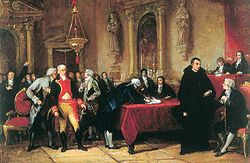 The signing of Venezuela's independence, by Martín Tovar y Tovar.
The signing of Venezuela's independence, by Martín Tovar y Tovar.
After a series of unsuccessful uprisings, Venezuela—under the leadership of Francisco de Miranda, a Venezuelan marshal who had fought in the American Revolution and the French Revolution—declared independence on 5 July 1811. This began the Venezuelan War of Independence. However, a devastating earthquake that struck Caracas in 1812, together with the rebellion of the Venezuelan llaneros, helped bring down the first Venezuelan republic.[19] A second Venezuelan republic, proclaimed on 7 August 1813, lasted several months before being crushed as well.
Sovereignty was only attained after Simón Bolívar, aided by José Antonio Páez and Antonio José de Sucre, won the Battle of Carabobo on 24 June 1821. José Prudencio Padilla and Rafael Urdaneta's victory in the Battle of Lake Maracaibo on 24 July 1823, helped seal Venezuelan independence. New Granada's congress gave Bolívar control of the Granadian army; leading it, he liberated several countries and founded Gran Colombia.
Sucre, who won many battles for Bolívar, went on to liberate Ecuador and later become the second president of Bolivia. Venezuela remained part of Gran Colombia until 1830, when a rebellion led by Páez allowed the proclamation of a newly independent Venezuela; Páez became the first president of the new republic. Between one- fourth and one-third of Venezuela's population was lost during these two decades of warfare (including perhaps one-half of the white population),[20] which by 1830 was estimated at about 800,000.[21]
The colors of the Venezuelan flag are yellow, blue and red, in that order: the yellow stands for land wealth, the blue for the sea that separates Venezuela from Spain, and the red for the blood shed by the heroes of independence.[22]
19th century
Much of Venezuela's 19th century history was characterized by political turmoil and dictatorial rule,[23] including Independence leader José Antonio Páez, who gained the presidency three times and served a total of eleven years between 1830 and 1863. This culminated in the Federal War (1859–1863), a civil war in which hundreds of thousands died, in a country with a population of not much more than a million people. In the latter half of the century Antonio Guzmán Blanco, another caudillo, served a total of thirteen years between 1870 and 1887, with three other presidents interspersed.
In 1895 a longstanding dispute with Great Britain about the territory of Guayana Esequiba, which Britain claimed as part of British Guiana and Venezuela saw as Venezuelan territory, erupted into the Venezuela Crisis of 1895. The dispute became a diplomatic crisis when Venezuela's lobbyist William L. Scruggs sought to argue that British behaviour over the issue violated the United States' Monroe Doctrine of 1823, and used his influence in Washington, D.C. to pursue the matter. Then US President Grover Cleveland adopted a broad interpretation of the Doctrine that did not just simply forbid new European colonies but declared an American interest in any matter within the hemisphere.[24] Britain ultimately accepted arbitration, but in negotiations over its terms was able to persuade the US on much of the details. A tribunal convened in Paris in 1898 to decide the issue, and in 1899 awarded the bulk of the disputed territory to British Guiana.[25]
20th century
Early 20th century
Main article: History of Venezuela#20th century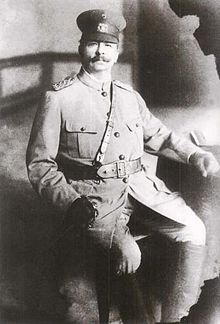 Juan Vicente Gómez ruled Venezuela during 27 years (1908–1935).
Juan Vicente Gómez ruled Venezuela during 27 years (1908–1935).
In 1899 Cipriano Castro, assisted by his friend Juan Vicente Gómez, seized power in Caracas, marching an army from his base in the Andean state of Táchira. Castro defaulted on Venezuela's considerable foreign debts, and declined to pay compensation to foreigners caught up in Venezuela's civil wars. This led to the Venezuela Crisis of 1902–1903, in which Britain, Germany and Italy imposed a naval blockade of several months, before international arbitration at the new Permanent Court of Arbitration in The Hague was agreed. In 1908 another dispute broke out with the Netherlands, which was resolved when Castro left for medical treatment in Germany and was promptly overthrown by Juan Vicente Gómez.
The discovery of massive oil deposits in Lake Maracaibo during World War I would prove pivotal for Venezuela, and soon transformed the basis of its economy, from a heavy dependence on agricultural exports. It prompted an economic boom that would last into the 1980s; by 1935, Venezuela's per capita gross domestic product was Latin America's highest.[26] Gómez benefited handsomely from this, as corruption thrived, but at the same time, the new source of income helped him centralise the Venezuelan state and develop its authority. He remained the most powerful man in Venezuela until his death in 1935, although at times he ceded the Presidency to others. The gomecista dictatorship system largely continued under Eleazar López Contreras, but from 1941, under Isaías Medina Angarita, was relaxed, with the latter granting a range of reforms, including the legalization of all political parties. After World War II the globalization and heavy immigration from Southern Europe (mainly from Spain, Italy, Portugal and France) and poorer Latin American countries markedly diversified Venezuelan society.
In 1945 a civilian-military coup overthrew Medina Angarita and ushered in a three-year period of democratic rule under the mass membership Democratic Action, initially under Rómulo Betancourt, until Rómulo Gallegos won the Venezuelan presidential election, 1947 (generally believed to be the first free and fair elections in Venezuela). Gallegos governed until overthrown by a military junta led by Marcos Pérez Jiménez and Gallegos' Defense Minister Carlos Delgado Chalbaud in the 1948 Venezuelan coup d'état. Pérez Jiménez was the most powerful man in the junta (though Chalbaud was its titular President), and was suspected of being behind the death in office of Chalbaud, who died in a bungled kidnapping in 1950. When the junta unexpectedly lost the election it held in 1952, it ignored the results and Pérez Jiménez was installed as President, where he remained until 1958.
Democratic period (1958–present)
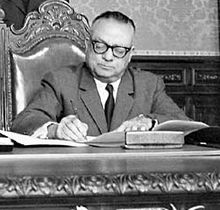 Rómulo Betancourt (President 1945-1948/1959-1964), one of the major democracy activists of Venezuela.
Rómulo Betancourt (President 1945-1948/1959-1964), one of the major democracy activists of Venezuela.
The military dictator Pérez Jiménez was forced out on 23 January 1958.[2] In an effort to consolidate the young democracy, the major political parties (with the notable exception of the Communist Party of Venezuela) signed the Punto Fijo Pact. Democratic Action and COPEI would dominate the political landscape for four decades. The 1960s saw substantial guerilla movements, including the Armed Forces of National Liberation and the Revolutionary Left Movement, which had split from Democratic Action in 1960. Most of these movements lay down their arms under Rafael Caldera's presidency (1969–74); Caldera had won the 1968 election for COPEI, being the first time a party other than Democratic Action took the presidency through a democratic election.
The election of Carlos Andrés Pérez in 1973 coincided with the 1973 oil crisis, which saw Venezuela's income explode as oil prices soared (Oil was nationalized in 1976). This led to massive increases in public spending, but also increases in external debts, which continued into the 1980s when the collapse of oil prices during the 1980s crippled the Venezuelan economy. As the government started to devalue the currency in February 1983 in order to face its financial obligations, Venezuelans' real standard of living fell dramatically. A number of failed economic policies and increasing corruption in government led to rising poverty and crime, worsening social indicators, and increased political instability.[27] Corruption remains a problem; Venezuela was ranked near the bottom of countries in the Corruptions Perceptions Index in 2009.[28]
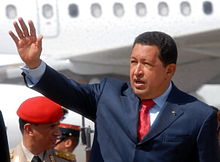 Hugo Chávez, President since 1999.
Hugo Chávez, President since 1999.
Economic crisis in the 1980s and 1990s led to a political crisis which saw hundreds dead in the Caracazo riots of 1989, two attempted coups in 1992,[29] and the impeachment of President Carlos Andrés Pérez (re-elected in 1988) for corruption in 1993. Coup leader Hugo Chávez was pardoned in March 1994 by president Rafael Caldera, with a clean slate and his political rights intact. A collapse in confidence in the existing parties saw Chávez elected President in 1998, and the subsequent launch of a "Bolivarian Revolution", beginning with a 1999 Constituent Assembly to write a new Constitution of Venezuela.
In April 2002, Chávez was briefly ousted from power in the 2002 Venezuelan coup d'état attempt following popular demonstrations by his opposers,[30] but he was returned to power after two days as a result of popular demonstrations by his supporters and actions by the military.[31] Chávez also remained in power after an all-out national strike that lasted more than two months in December 2002 – February 2003, including a strike/lockout in the state oil company PDVSA, and an August 2004 recall referendum. He was elected for another term in December 2006.
Geography
Main article: Geography of VenezuelaVenezuela is located in the north of South America; geologically its mainland rests on the South American Plate. It has a total area of 916,445 square kilometres (353,841 sq mi) and a land area of 882,050 square kilometres (340,560 sq mi), making it the 33rd largest country. The territory it controls lies between latitudes 0° and 13°N, and longitudes 59° and 74°W.
Shaped roughly like an inverted triangle, the country has a 2,800 kilometres (1,700 mi) coastline in the north, which includes numerous islands in the Caribbean Sea, and in the north east borders the northern Atlantic Ocean. Most observers describe Venezuela in terms of four fairly well-defined topographical regions: the Maracaibo lowlands in the northwest, the northern mountains extending in a broad east-west arc from the Colombian border along the northern Caribbean coast, the wide plains in central Venezuela, and the Guiana highlands in the southeast.
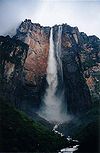 Angel Falls, the highest waterfall in the world
Angel Falls, the highest waterfall in the world
The northern mountains are the extreme northeastern extensions of South America's Andes mountain range reach. Pico Bolívar, the nation's highest point at 4,979 metres (16,335 ft), lies in this region. To the south, the dissected Guiana Highlands contains the northern fringes of the Amazon Basin and Angel Falls, the world's highest waterfall as well as tepuis, large table-like mountains. The country's center is characterized by the llanos, which are extensive plains that stretch from the Colombian border in the far west to the Orinoco River delta in the east. The Orinoco, with its rich alluvial soils, binds the largest and most important river system of the country; it originates in one of the largest watersheds in Latin America. The Caroní and the Apure are other major rivers.
Venezuela borders Colombia to the west, Guyana to the east, and Brazil to the south. Caribbean islands such as Trinidad and Tobago, Grenada, Curaçao, Aruba and the Leeward Antilles lie near the Venezuelan coast. Venezuela has territorial disputes with Guyana (formerly United Kingdom), largely concerning the Essequibo area, and with Colombia concerning the Gulf of Venezuela. In 1895, after years of diplomatic attempts to solve the border dispute, from Venezuela, the dispute over the Essequibo River border flared up, it was submitted to a "neutral" commission (composed of United Kingdom, United States and Russian representatives and without a direct Venezuelan representative), which in 1899 decided mostly against Venezuela's claim.[32]
Venezuela most significant natural resources are petroleum and natural gas, iron ore, gold and other minerals. It also has large areas of arable land and water.
Climate
Main article: Climate of Venezuela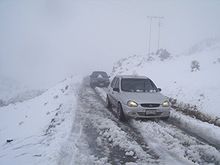 Snow in Mérida
Snow in Mérida
Though Venezuela is entirely situated in the tropics, its climate varies from humid low-elevation plains, where average annual temperatures range as high as 28 °C (82.4 °F), to glaciers and highlands (the páramos) with an average yearly temperature of 8 °C (46.4 °F). Annual rainfall varies between 430 millimetres (16.9 in) in the semiarid portions of the northwest to 1,000 millimetres (39.4 in) in the Orinoco Delta of the far east. Most precipitation falls between June and October (the rainy season or "winter"); the drier and hotter remainder of the year is known as "summer", though temperature variation throughout the year is not as pronounced as at temperate latitudes.[23]
The country falls into four horizontal temperature zones based primarily on elevation, having Tropical, Dry, Temperate with Dry Winters, and Polar (Alpine tundra) climates, amongst others.[33][34][35] In the tropical zone—below 800 meters / 2,625 feet—temperatures are hot, with yearly averages ranging between 26 and 28 °C (78.8 and 82.4 °F). The temperate zone ranges between 800 and 2,000 meters (2,625 and 6,562 ft) with averages from 12 to 25 °C (53.6 to 77 °F); many of Venezuela's cities, including the capital, lie in this region. Colder conditions with temperatures from 9 to 11 °C (48.2 to 51.8 °F) are found in the cool zone between 2,000 and 3,000 meters (6,562 and 9,843 ft), especially in the Venezuelan Andes, where Pastureland and permanent snowfield with yearly averages below 8 °C (46 °F) cover land above 3,000 meters (9,843 ft) in the high mountain areas known as the páramos.
Biodiversity
Main articles: Fauna of Venezuela, Flora of Venezuela, National symbols of Venezuela, and List of birds of VenezuelaVenezuela lies within the Neotropic ecozone; large portions of the country were originally covered by moist broadleaf forests. One of seventeen megadiverse countries,[36] Venezuela's habitats range from the Andes mountains in the west to the Amazon Basin rainforest in the south, via extensive llanos plains and Caribbean coast in the center and the Orinoco River Delta in the east. They include xeric scrublands in the extreme northwest and coastal mangrove forests in the northeast.[23] Its cloud forests and lowland rainforests are particularly rich.[37]
Animals of Venezuela are diverse and include manatees, Amazon river dolphins, and Orinoco crocodiles, which have been reported to reach up to 6.6 metres (22 ft) in length. Venezuela hosts a total of 1,417 bird species, 48 of which are endemic.[38] Important birds include ibises, ospreys, kingfishers,[37] and the yellow-orange turpial, the national bird. Notable mammals include the Giant Anteater, jaguar, and the capybara, the world's largest rodent. More than half of Venezuelan avian and mammalian species are found in the Amazonian forests south of the Orinoco.[39]
For the fungi, an account was provided by R.W.G. Dennis[40] which has been digitized and the records made available on-line as part of the Cybertruffle Robigalia database.[41] That database includes nearly 3900 species of fungi recorded from Venezuela, but is far from complete, and it is likely that the true total number of fungal species already known from Venezuela is higher. The true total number of fungal species occurring in Venezuela, including species not yet recorded, is likely to be far higher, given the generally accepted estimate that only about 7% of all fungi worldwide have so far been discovered.[42]
 The araguaney (Tabebuia chrysantha), Venezuela's national tree.
The araguaney (Tabebuia chrysantha), Venezuela's national tree.
Among plants of Venezuela, over 25,000 species of orchids are found in the country's cloud forests and lowland rainforests ecosystems.[37] These include the flor de mayo orchid (Cattleya mossiae), the national flower. Venezuela's national tree is the araguaney, whose characteristic lushness after the rainy season led novelist Rómulo Gallegos to name it «[l]a primavera de oro de los araguaneyes» ("the golden spring of the araguaneyes").
Venezuela is among the top twenty countries in terms of endemism.[43] Among its animals, 23% of reptilian and 50% of amphibian species are endemic.[43] Although the amount of available information is still very small, a first effort has been made to estimate the number of fungal species endemic to Venezuela: 1334 species of fungi have been tentatively identified as possible endemics of the country.[44] Some 38% of the over 21,000 plant species known from Venezuela are unique to the country.[43]
Environment
In recent decades, logging, mining, shifting cultivation, development, and other human activities have posed a major threat to Venezuela's wildlife; between 1990 and 2000, 0.40% of forest cover was cleared annually.[43] In response, federal protections for critical habitat were implemented; for example, 20% to 33% of forested land is protected.[39] The country has a biosphere reserve that is part of the World Network of Biosphere Reserves; five wetlands are registered under the Ramsar Convention.[45] In 2003, 70% of the nation's land was under conservation management in over 200 protected areas, including 43 national parks.[46] Venezuela's 43 national parks include Canaima National Park, Morrocoy National Park and Mochima National Park.
Subdivisions
Main articles: States of Venezuela and Regions of VenezuelaVenezuela is divided into 23 states (estados), a capital district (distrito capital) corresponding to the city of Caracas, and the Federal Dependencies (Dependencias Federales, a special territory). Venezuela is further subdivided into 335 municipalities (municipios); these are subdivided into over one thousand parishes (parroquias). The states are grouped into nine administrative regions (regiones administrativas), which were established in 1969 by presidential decree; in addition, Venezuela has historically claimed and continues to claim all Guyanese territory west of the Essequibo River; this 159,500 square kilometres (61,583 sq mi) tract was dubbed Guayana Esequiba or the Zona en Reclamación (the "zone to be reclaimed").[47]
The country can be further divided into ten geographical areas, some corresponding to climatic and biogeographical regions. In the north are the Venezuelan Andes and the Coro region, a mountainous tract in the northwest, holds several sierras and valleys. East of it are lowlands abutting Lake Maracaibo and the Gulf of Venezuela. The Central Range runs parallel to the coast and includes the hills surrounding Caracas; the Eastern Range, separated from the Central Range by the Gulf of Cariaco, covers all of Sucre and northern Monagas. The Insular Region includes all of Venezuela's island possessions: Nueva Esparta and the various Federal Dependencies. The Orinoco Delta, which forms a triangle covering Delta Amacuro, projects northeast into the Atlantic Ocean.
- States
Name Capital 1  Amazonas
AmazonasPuerto Ayacucho 2 Anzoátegui
Barcelona 3  Apure
ApureSan Fernando de Apure 4  Aragua
AraguaMaracay 5  Barinas
BarinasBarinas 6  Bolívar
BolívarCiudad Bolívar 7  Carabobo
CaraboboValencia 8  Cojedes
CojedesSan Carlos 9  Delta Amacuro
Delta Amacuro Tucupita 10  Falcón
FalcónCoro 11  Guárico
GuáricoSan Juan de los Morros 12  Lara
LaraBarquisimeto Name Capital 13  Mérida
MéridaMérida 14  Miranda
MirandaLos Teques 15  Monagas
MonagasMaturín 16  Nueva Esparta
Nueva Esparta La Asunción 17  Portuguesa
PortuguesaGuanare 18  Sucre
SucreCumaná 19  Táchira
TáchiraSan Cristóbal 20  Trujillo
TrujilloTrujillo 21  Vargas
VargasLa Guaira 22  Yaracuy
YaracuySan Felipe 23  Zulia
ZuliaMaracaibo - Dependencies
Name Capital •  Federal Dependencies
Federal Dependencies(none) - Administrative regions
Name Subregions AndeanBarinas, Mérida, Táchira, Trujillo, Páez Municipality of Apure CapitalMiranda, Vargas, Capital District CentralAragua, Carabobo, Cojedes Central-WesternFalcón, Lara, Portuguesa, Yaracuy GuayanaBolívar, Amazonas, Delta Amacuro InsularNueva Esparta, Federal Dependencies LlanosApure (excluding Paez Municipality), Guárico North-EasternAnzoátegui, Monagas, Sucre ZulianZulia Economy
Main article: Economy of VenezuelaVenezuela has a mixed economy dominated by the petroleum sector, which accounts for roughly a third of GDP, around 80% of exports and more than half of government revenues. It suffers high levels of corruption.[48] Per capita GDP for 2009 was US$13,000, ranking it 85th in the world.[49] About 30% of the population of the country live on less than US $2 per day.[50] Venezuela has the least expensive petrol in the world because the consumer price of petrol is so heavily subsidised.
Manufacturing contributed 17% of GDP in 2006. Venezuela manufactures and exports heavy industry items such as steel, aluminium and cement, with production concentrated around Ciudad Guayana, near the Guri Dam, one of the largest in the world and the provider of about three quarters of Venezuela's electricity. Other notable manufacturing includes electronics and automobiles, as well as beverages, and foodstuffs. Agriculture in Venezuela accounts for approximately 3% of GDP, 10% of the labor force, and at least one-fourth of Venezuela's land area. Venezuela exports rice, corn, fish, tropical fruit, coffee, beef, and pork. The country is not self-sufficient in most areas of agriculture; Venezuela imports about two-thirds of its food needs.
Since the discovery of oil in the early 20th century, Venezuela has been one of the world's leading exporters of oil, and it is a founder member of OPEC. Previously an underdeveloped exporter of agricultural commodities such as coffee and cocoa, oil quickly came to dominate exports and government revenues. The 1980s oil glut led to an external debt crisis and a long-running economic crisis, which saw inflation peak at 100% in 1996 and poverty rates rise to 66% in 1995[6] as (by 1998) per capita GDP fell to the same level as 1963, down a third from its 1978 peak.[7] The 1990s also saw Venezuela experience a major banking crisis in 1994. The recovery of oil prices after 2001 boosted the Venezuelan economy and facilitated social spending, although the fallout of the 2008 global financial crisis saw a renewed economic downturn.
Petroleum and other resources
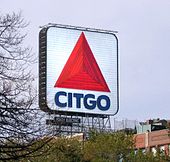 The Venezuelan oil producer PDVSA wholly owns its United States-based subsidiary, Citgo and attributes a large percentage of its wealth to oil sales from the United States
The Venezuelan oil producer PDVSA wholly owns its United States-based subsidiary, Citgo and attributes a large percentage of its wealth to oil sales from the United States
Venezuela has some of the largest oil and natural gas reserves in the world, and consistently ranks among the top ten crude oil producers in the world.[51] Compared to the preceding year another 40.4 percent in crude oil reserves were proven in 2010, allowing Venezuela to surpass Saudi Arabia as the country with the larges reserves of this type.[52] The country's main petroleum deposits are located around and beneath Lake Maracaibo, the Gulf of Venezuela (both in Zulia), and in the Orinoco River basin (eastern Venezuela), where the country's largest reserve is located. Besides the largest conventional oil reserves and the second-largest natural gas reserves in the Western Hemisphere,[53] Venezuela has non-conventional oil deposits (extra-heavy crude oil, bitumen and tar sands) approximately equal to the world's reserves of conventional oil.[54] The electricity sector in Venezuela is one of the few to rely primarily on hydropower, and includes the Guri Dam, one of the largest in the world.
In the first half of the 20th century, US oil companies were heavily involved in Venezuela, initially on the basis of purchasing concessions.[55] In 1943 a new government introduced a 50/50 split in profits between the government and the oil industry. In 1960, with a newly installed democratic government, Hydrocarbons Minister Juan Pablo Pérez Alfonso led the creation of OPEC, the consortium of oil-producing countries aiming to support the price of oil.[56] In 1973 Venezuela voted to nationalize its oil industry outright, effective 1 January 1976, with Petróleos de Venezuela (PDVSA) taking over and presiding over a number of holding companies; in subsequent years, Venezuela built a vast refining and marketing system in the U.S. and Europe.[57] In the 1990s PDVSA became more independent from the government and presided over an apertura (opening) in which it invited in foreign investment. Under Hugo Chávez a 2001 law placed limits on foreign investment.
The state oil company PDVSA played a key role in the December 2002 – February 2003 national strike which sought President Chávez' resignation. Managers and skilled highly paid technicians of PDVSA shut down the plants and left their posts, and by some reports sabotaged equipment, and petroleum production and refining by PDVSA almost ceased. Activities eventually were slowly restarted by returning and substitute oil workers. As a result of the strike, around 40% of the company's workforce (around 18,000 workers) were dismissed for "dereliction of duty" during the strike.[58][59]
Transport
Main article: Transport in VenezuelaVenezuela is connected to the world primarily via air (Venezuela's airports include the Simón Bolívar International Airport near Caracas and La Chinita International Airport near Maracaibo) and sea (with major sea ports at La Guaira, Maracaibo and Puerto Cabello). In the south and east the Amazon rainforest region has limited cross-border transport; in the west, there is a mountainous border of over 1,375 miles (2,213 km) shared with Colombia. The Orinoco River is navigable by oceangoing vessels up to 400 km inland, and connects the major industrial city of Ciudad Guayana to the Atlantic Ocean.
Venezuela has a limited national railway system, which has no active rail connections to other countries; the government of Hugo Chávez has invested substantially in expanding it.[citation needed] Several major cities have metro systems; the Caracas Metro has been operating since 1983. The Maracaibo Metro and Valencia Metro were opened more recently. Venezuela has a road network of around 100,000 km (placing it around 47th in the world);[citation needed] around a third of roads are paved.
Demographics
Main article: Demographics of VenezuelaPopulation in Venezuela[60] Year Million 1971 11,1 1990 19,8 2009 28,4 Source: OECD/World Bank Venezuelans have a rich combination of heritages. From the colonial period were mixed Amerindians, Spanish and African, and today the majority of Venezuelans have mixed ancestry, ie people who have an Amerindians ancestor, black and white. Since 1990 there is no record of the ethnography of the Venezuelan population, but according to statistics from the continues with a constant immigration which has increased the white and black population, leaving the mixed in slow growth. These statistics expose approximate results: 50% mestizo, or white, mostly descendants of the Europeans and Arabs by 29%, 10% African descent, and indigenous people with only 1% of the total population. During the colonial period and until after the Second World War, much of European immigrants to Venezuela came from the Canary Islands, and its cultural impact was significant in influencing the development of Castilian in the country, its cuisine and customs.
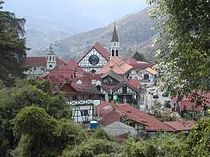 Colonia Tovar Founded in 1843 with Catholic settlers from south of Germany. Its people maintain their culture and language, and speak a dialect called German coloniero.
Colonia Tovar Founded in 1843 with Catholic settlers from south of Germany. Its people maintain their culture and language, and speak a dialect called German coloniero.
With the start of oil exploitation in the early twentieth century, established companies and citizens from much of the United States. Later, during the war, he joined the Venezuelan society a new wave of immigrants from Italy and Spain, and new immigrants from Portugal, the Middle East, Germany, Croatia, the Netherlands, China, among others, are encouraged both by the immigration and colonization program established by the Government. Between 1900 and 1958 more than one million Europeans immigrated to Venezuela creating great communities, highlighting the Italo-Venezuelans, Iberian-Venezuelans and Portuguese-Venezuelans. Venezuela is the third country in the world to have the largest community of Spanish after Argentina and France, the third country to have the largest community of Portuguese after Brazil and the U.S. and the third country to have the largest colony of Italians in Latin America after Argentina and Uruguay. Immigration in Venezuela also came from many Latin American countries primarily in Colombia during the oil boom of the 1970s. These continuous waves of immigration increased the country's complex racial mosaic. The Venezuelan population born in other countries accounted for 4.4% of the national total. Today, the increased immigration from Colombia, Spain, Portugal and Italy among other countries such as Trinidad and Tobago.
Two of the main Amerindian tribes located in the country are the Wayuu, located in the west, in Zulia State, and the Timotocuicas, also in the west, in Mérida State, in the Andes.[citation needed] Other important groups include Afro-Venezuelans, though their numbers are unclear due to poor census data.[61]
Asians make up a small percentage of the population. About 1% of Venezuelans are indigenous.[62] These groups were joined by sponsored migrants from throughout Europe and neighboring parts of South America by the mid-20th century economic boom.
According to the World Refugee Survey 2008, published by the U.S. Committee for Refugees and Immigrants, Venezuela hosted a population of refugee and asylum seekers from Colombia numbering 252,200 in 2007. 10,600 new asylum seekers entered Venezuela in 2007.[63] Between 500,000 and one million illegal immigrants are estimated to be living in the Venezuela.[64]
Urbanization
Venezuela is among the most urbanized countries in Latin America;[4][5] the vast majority of Venezuelans live in the cities of the north, especially in the capital Caracas which is also the largest city. About 93% of the population live in urban areas in northern Venezuela; 73% live less than 100 kilometres (62 mi) from the coastline.[65] Though almost half of Venezuela's land area lies south of the Orinoco, only 5% of Venezuelans live there. The largest and most important city south of the Orinoco is Ciudad Guayana, which is the sixth most populous conurbation.[66] Other major cities include Maracaibo, Valencia, Maracay, Barquisimeto, Mérida, San Cristóbal and Barcelona-Puerto La Cruz.
Languages
Main article: Languages of VenezuelaAlthough the country is mostly monolingual Castilian, many languages are spoken in Venezuela. In addition to Castilian, the Constitution recognizes more than thirty indigenous languages, Wayuu, Warao, pemón and many others for the official use of the Amerindian peoples, mostly with few speakers, less than 1% of the total population. Immigrants, in addition to Spanish, they speak their own languages. Arabic is spoken by Lebanese and Syrian colonies on Isla de Margarita, Maracaibo, Punto Fijo, Puerto la Cruz, El Tigre, Maracay and Caracas. Portuguese is spoken, as well as the Portuguese community in Santa Elena de Uairén for much of the population due to its proximity to Brazil. The German community speaks their native language, while the Colonia Tovar speaks mostly Alemannic dialect of German called coloniero. English is the most widely used foreign language and demand, and is spoken by many professionals, academics and part of the upper and middle classes as a result of oil exploration by foreign companies, in addition to its acceptance as a lingua franca. Culturally, English is common in southern towns like El Callao, for the Anglophone West Indian influence evident in folk songs and calypso Venezuelan and French with English voices. Italian instruction is guaranteed by the presence of a constant number of schools and private institutions, because the Italian government considered mandatory language teaching at school level. Other languages spoken by large communities from drawing in the country are Chinese and Galicia, among others.
Religion
Main article: Religion in VenezuelaAccording to government estimates, 92% of the population is at least nominally Roman Catholic, and the remaining 8% are Protestant, or a member of another religion. The Venezuelan Evangelical Council estimates that Evangelical Protestants constitute 10% of the population.[67]
Education
Main article: Education in VenezuelaIn 2008, 95.2% of the adult population was literate.[68] Net primary school enrollment rate was at 91 % in 2005.[68] Net secondary enrollment rate was at 63 % in 2005.[68] Venezuela has a number of universities, of which the most prestigious is the Central University of Venezuela (UCV), founded in Caracas in 1721, and Simón Bolívar University (USB), founded in Miranda State in 1967.
Health
Main articles: Health care in Venezuela and Mission Barrio AdentroUniversity Hospital, Central University of Venezuela
Venezuela has a national universal health care system that is free of charge. The current government has created a program to expand access to health care known as Misión Barrio Adentro.[69][70]
Infant mortality in Venezuela stood at 16 deaths per 1,000 births in 2004, lower than the South American average (by comparison, the U.S. stands at 5 deaths per 1,000 births in 2006).[71][72][73] Child malnutrition (defined as stunting or wasting in children under age five) stands at 17%; Delta Amacuro and Amazonas have the nation's highest rates.[74] According to the United Nations, 32% of Venezuelans lack adequate sanitation, primarily those living in rural areas.[75] Diseases ranging from typhoid, yellow fever, cholera, hepatitis A, hepatitis B, and hepatitis D are present in the country.[76]
Venezuela has a total of 150 plants for sewage treatment. However still 13% of the population lack access to drinking water but this number has been dropping.[77]
Crime
Main article: Crime in VenezuelaCorruption in Venezuela is high by world standards, and has been for much of the 20th century. The discovery of oil had worsened political corruption,[78] and by the late 1970s, Juan Pablo Pérez Alfonzo's description of oil as "the Devil's excrement" had become a common expression in Venezuela.[79] Venezuela has been ranked one of the most corrupt countries on the Corruption Perceptions Index since the survey started in 1995. The 2010 ranking placed Venezuela at number 164, out of 178 ranked countries.[80]
Venezuela is a significant route for drug trafficking, with Colombian cocaine and other drugs transiting Venezuela towards the United States and Europe. Venezuela ranks fourth in the world for cocaine seizures, behind Colombia, the United States, and Panama.[81]
In 2009, the homicide rate was approximately 57 per 100,000, one of the world’s highest, having trebled in the previous decade (according to The Economist).[82] The capital Caracas has the second greatest homicide rate of any large city in the world, with 92 homicides per 100,000 residents.[83] There have been 118,541 homicides in Venezuela between 1999 and 2010.[84] In 2008, polls indicated that crime was the number one concern of voters.[85] The government recently created a security force the Bolivarian National Police, which has lowered crime rates in the areas in which it is so far deployed and a new Experimental Security University.[86]
Government
Main article: Government of Venezuela National Assembly of Venezuela Building
National Assembly of Venezuela Building
Executive
The Venezuelan president is elected by a vote, with direct and universal suffrage, and is both head of state and head of government. The term of office is six years, and (as of 15 February 2009) a president may be re-elected an unlimited number of times. The president appoints the vice-president and decides the size and composition of the Cabinet and makes appointments to it with the involvement of the legislature. The president can ask the legislature to reconsider portions of laws he finds objectionable, but a simple parliamentary majority can override these objections.
The President may ask the National Assembly to pass an enabling act granting the ability to rule by decree in specified policy areas; this requires a two-thirds majority in the Assembly. Since 1959 six Presidents have been granted such powers.
Legislative
The unicameral Venezuelan parliament is the Asamblea Nacional ("National Assembly"). The number of members is variable, each state and the Capital district elect three representatives plus the result of dividing the state population by 1.1% of the total population of the country.[87] Three seats are reserved for representatives of Venezuela's indigenous peoples. For the 2010–2015 period the number of seats is 165.[88] All deputies serve five-year terms.
The voting age in Venezuela is 18 and older. Voting is not compulsory.[89]
Judicial
Main articles: Judiciary of Venezuela and Law enforcement in VenezuelaThe legal system of Venezuela belongs to the Continental Law tradition. The highest judicial body is the Supreme Tribunal of Justice or Tribunal Supremo de Justicia, whose magistrates are elected by parliament for a single twelve-year term. The National Electoral Council (Consejo Nacional Electoral, or CNE) is in charge of electoral processes; it is formed by five main directors elected by the National Assembly. Supreme Court president Luisa Estela Morales said in December 2009 that Venezuela had moved away from "a rigid division of powers" toward a system characterized by "intense coordination" between the branches of government. Morales clarified that each power must be independent adding that "one thing is separation of powers and another one is division".[90]
Foreign relations
Main article: Foreign relations of VenezuelaThroughout most of the 20th century, Venezuela maintained friendly relations with most Latin American and Western nations. Relations between Venezuela and the United States government worsened in 2002, after the 2002 Venezuelan coup d'état attempt during which the U.S. government recognized the short-lived interim presidency of Pedro Carmona. Correspondingly, ties to various Latin American and Middle Eastern countries not allied to the U.S. have strengthened.
Venezuela seeks alternative hemispheric integration via such proposals as the Bolivarian Alternative for the Americas trade proposal and the newly launched pan-Latin American television network teleSUR. Venezuela is one of the four nations in the world—along with Russia, Nicaragua and Nauru—to have recognized the independence of Abkhazia and South Ossetia. Venezuela was a proponent of OAS's decision to adopt its Anti-Corruption Convention, and is actively working in the Mercosur trade bloc to push increased trade and energy integration. Globally, it seeks a "multi-polar" world based on strengthened ties among Third World countries.
Military
The National Armed Forces of the Bolivarian Republic of Venezuela (Fuerza Armada Nacional, FAN) are the overall unified military forces of Venezuela. It includes over 320,150 men and women, under Article 328 of the Constitution, in 5 components of Ground, Sea and Air. The components of the National Armed Forces are: the Venezuelan Army, the Venezuelan Navy, the Venezuelan Air Force, the Venezuelan National Guard, and the Venezuelan National Militia.
As of 2008, a further 600,000 soldiers were incorporated into a new branch, known as the Armed Reserve. The President of Venezuela is the commander-in-chief of the national armed forces. The main roles of the armed forces are to defend the sovereign national territory of Venezuela, airspace, and islands, fight against drug trafficking, to search and rescue and, in the case of a natural disaster, civil protection. All men that are citizens of Venezuela have a constitutional duty to register for the military at the age of 18, which is the age of majority in Venezuela.
Politics
Main article: Politics of VenezuelaFollowing the fall of Marcos Pérez Jiménez in 1958, Venezuelan politics was dominated by the third-way Christian democratic COPEI and the center-left social democratic Democratic Action (AD) parties; this two-party system was formalized by the puntofijismo arrangement. Economic crisis in the 1980s and 1990s led to a political crisis which saw hundreds dead in the Caracazo riots of 1989, two attempted coups in 1992, and the impeachment of President Carlos Andrés Pérez for corruption in 1993. A collapse in confidence in the existing parties saw the 1998 election of former coup leader Hugo Chávez, and the launch of a "Bolivarian Revolution", beginning with a 1999 Constituent Assembly to write a new Constitution of Venezuela.
The opposition's attempts to unseat Chávez included the 2002 Venezuelan coup d'état attempt, the Venezuelan general strike of 2002–2003, and the Venezuelan recall referendum, 2004, all of which failed. Chávez was re-elected in December 2006, but suffered a significant defeat in 2007 with the narrow rejection of the Venezuelan constitutional referendum, 2007, which had offered two packages of constitutional reforms aimed at deepening the Bolivarian Revolution.
There are currently two major blocs of political parties in Venezuela: the incumbent leftist bloc United Socialist Party of Venezuela (PSUV), its major allies Fatherland for All (PPT) and the Communist Party of Venezuela (PCV), and the opposition bloc grouped into the electoral coalition Mesa de la Unidad Democrática. This includes A New Era (UNT) together with allied parties Project Venezuela, Justice First, Movement for Socialism and others.
Culture
Main articles: Culture of Venezuela, Music of Venezuela, and Sport in Venezuela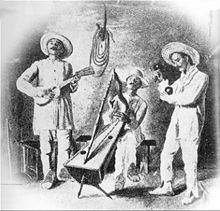 The joropo, as depicted in a 1912 drawing by Eloy Palacios
The joropo, as depicted in a 1912 drawing by Eloy Palacios
The culture of Venezuela is a melting pot which includes mainly to three different families,the indigenous, African and Spanish. The first two cultures were in turn differentiated according to the tribes. Acculturation and assimilation, typical of a cultural syncretism, conditioned to arrive at the current Venezuelan culture, similar in many respects to the rest of Latin America, although the natural environment means that there are important differences. The indigenous influence is limited to a few words of vocabulary and gastronomy. The African influence in the same way, in addition to musical instruments like the drum. The Spanish influence was more important and in particular came from the regions of Andalusia and Extremadura, places of origin most settlers in the Caribbean during the colonial era. As an example of this can include buildings, part of the music, the Catholic religion and language. Spanish influences are evident bullfights and certain features of gastronomy. Venezuela also enriched by other streams of Indian and European origin in the nineteenth century, especially from France. In the latest stage in the major cities and regions stormed oil of U.S. origin and manifestations of the new immigration of Spanish, Italian and Portuguese, increasing the already complex cultural mosaic. For example, from United States comes the influence of taste for baseball and current architectural constructions.
Art
Main article: Art of VenezuelaVenezuelan art was initially dominated by religious motifs, but began emphasizing historical and heroic representations in the late 19th century, a move led by Martín Tovar y Tovar. Modernism took over in the 20th century. Notable Venezuelan artists include Arturo Michelena, Cristóbal Rojas, Armando Reverón, Manuel Cabré; the kinetic artists Jesús-Rafael Soto and Carlos Cruz-Díez; and contemporary artist Yucef Merhi.
Literature
Main article: Venezuelan literatureVenezuelan literature originated soon after the Spanish conquest of the mostly pre-literate indigenous societies; it was dominated by Spanish influences. Following the rise of political literature during the Venezuelan War of Independence, Venezuelan Romanticism, notably expounded by Juan Vicente González, emerged as the first important genre in the region. Although mainly focused on narrative writing, Venezuelan literature was advanced by poets such as Andrés Eloy Blanco and Fermín Toro.
Major writers and novelists include Rómulo Gallegos, Teresa de la Parra, Arturo Uslar Pietri, Adriano González León, Miguel Otero Silva, and Mariano Picón Salas. The great poet and humanist Andrés Bello was also an educator and intellectual. Others, such as Laureano Vallenilla Lanz and José Gil Fortoul, contributed to Venezuelan Positivism.
Music
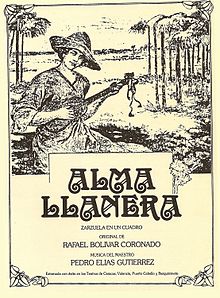 Cover of Alma Llanera
Cover of Alma Llanera Main article: Music of Venezuela
Main article: Music of VenezuelaIndigenous musical styles of Venezuela are exemplified by the groups Un Solo Pueblo and Serenata Guayanesa. The national musical instrument is the cuatro. Typical musical styles and pieces mainly emerged in and around the llanos region, including Alma Llanera (by Pedro Elías Gutiérrez and Rafael Bolívar Coronado), Florentino y el Diablo (by Alberto Arvelo Torrealba), Concierto en la Llanura by Juan Vicente Torrealba, and Caballo Viejo (by Simón Díaz).
The Zulian gaita is also a popular style, generally performed during Christmas. The national dance is the joropo. Teresa Carreño was a world-famous 19th century piano virtuosa. In the last years, Classical Music has had great performances. The Simon Bolivar Youth Orchestra, under the baton of its principal conductor Gustavo Dudamel, has hosted a number of excellent presentations in many European concert halls, notably at the 2007 London Proms, and has received several honors. The orchestra is the pinnacle of El Sistema, a publicly financed voluntary sector music education program now being emulated in other countries.
Sport
Main article: Sport in VenezuelaSee also: Baseball in VenezuelaBaseball is Venezuela's most popular sport, with the Venezuelan Professional Baseball League existing since 1945. In recent years football, spearheaded by the Venezuela national football team, is gaining popularity.
Other
Venezuela is well-known for its successes in beauty pageants. Miss Venezuela is a big event in the country, and Venezuela has received 6 Miss World, 6 Miss Universe, 6 Miss International and 1 Miss Earth titles.
Carlos Raúl Villanueva was the most important Venezuelan architect of the modern era; he designed the Central University of Venezuela, (a World Heritage Site) and its Aula Magna. Other notable architectural works include the Capitolio, the Baralt Theatre, the Teresa Carreño Cultural Complex, and the General Rafael Urdaneta Bridge.
See also
- Outline of Venezuela
- Index of Venezuela-related articles
- International rankings of Venezuela
- List of Venezuelans
- South America Life Quality Rankings
- South America Life Quality Rankings - Economy and Finance
- South America Life Quality Rankings - Law and Justice
References
- ^ a b c d "Venezuela". International Monetary Fund. http://www.imf.org/external/pubs/ft/weo/2010/02/weodata/weorept.aspx?pr.x=76&pr.y=7&sy=2007&ey=2010&scsm=1&ssd=1&sort=country&ds=.&br=1&c=299&s=NGDP_RPCH,NGDPD,NGDPDPC,PPPGDP,PPPPC&grp=0&a=. Retrieved 10 October 2010.
- ^ a b "Venezuela". The World Factbook. CIA. 1 July 2010. https://www.cia.gov/library/publications/the-world-factbook/geos/ve.html. Retrieved 23 July 2010.
- ^ "Human Development indicator for the Bolivarian Republic of Venezuela". United Nations. 2011. http://hdrstats.undp.org/en/countries/profiles/VEN.html. Retrieved 5 November 2011.
- ^ a b "South America". South America. Encarta. http://encarta.msn.com/encyclopedia_761574914_3/South_America.html. Retrieved 13 March 2007.
- ^ a b "Annex tables" (PDF). World Urbanization Prospects: The 1999 Revision. United Nations. http://www.un.org/esa/population/publications/wup1999/WUP99ANNEXTABLES.pdf. Retrieved 13 March 2007.
- ^ a b McCaughan, Michael. The Battle of Venezuela. New York: Seven Stories Press. 2005. p 32.
- ^ a b Kelly, Janet, and Palma, Pedro (2006), "The Syndrome of Economic Decline and the Quest for Change", in McCoy, Jennifer and Myers, David (eds, 2006), The Unraveling of Representative Democracy in Venezuela, Johns Hopkins University Press. p207
- ^ Venezuela. Lonely Planet. 2004. ISBN 9781741041972. ISBN 1-74104-197-X. http://books.google.com/?id=JDdb1alDGYIC. Retrieved 10 March 2007.. p. 177.
- ^ a b Venezuela: A Petro-State Using Renewable Energies: A Contribution to the... at Google Books By Germán Massabié
- ^ Thomas, Hugh (2005). Rivers of Gold: The Rise of the Spanish Empire, from Columbus to Magellan. Random House. p. 189. ISBN 0-37550-204-1.
- ^ (in Spanish) Cuadernos Hispanoamericanos. Instituto de Cultura Hispánica (Agencia Española de Cooperación Internacional). 1958. p. 386.
- ^ Kipfer, Barbara Ann (2000). Encyclopedic Dictionary of YUPArchaeology. Springer. p. 91. ISBN 0-30646-158-7.
- ^ Kipfer 2000, p. 172.
- ^ a b c d e Wunder, Sven (2003), Oil wealth and the fate of the forest: a comparative study of eight tropical countries, Routledge. p130.
- ^ Zamora, Margarita (© 1993 The Regents of the University of California). Reading Columbus. Berkeley and Los Angeles, California: UNIVERSITY OF CALIFORNIA PRESS. pp. Voyage to Paradise. ISBN 0-520-08297-4. http://publishing.cdlib.org/ucpressebooks/view?docId=ft009nb0cv&doc.view=content&chunk.id=d0e2655&toc.depth=1&anchor.id=0&brand=eschol. Retrieved 23 April 2010.
- ^ "Alcaldía del Hatillo: Historia" (in Spanish). Universidad Nueva Esparta. http://www.une.edu.ve/hatillo/historia.htm. Retrieved 10 March 2007.
- ^ Gott (2005:203)
- ^ Ewell, Judith (1984), Venezuela:A Century of Change, C. Hurst & Co, p4
- ^ Chasteen, John Charles (2001). Born in Blood and Fire: A Concise History of Latin America. Norton. ISBN 9780393050486. http://books.google.com/?id=fC90B5xkYyIC&pg=PP1&lpg=PP1&dq=Born+in+blood+and+fire. Retrieved 10 March 2007. p. 103.
- ^ Stoan, Stephen K. (1974). Pablo Morillo and Venezuela, 1815–1820. Ohio State University Press. p. 29.
- ^ "Venezuela – The Century of Caudillismo". Library of Congress Country Studies.
- ^ "200 años como símbolo de soberanía" (in Spanish). Consulado General de Venezuela en Canarias. http://www.consuladodevenezuela.es/contenido.php?idNot=216. Retrieved 30 November 2010.
- ^ a b c "Country Profile: Venezuela" (PDF). Library of Congress (Federal Research Division). 2005. http://lcweb2.loc.gov/frd/cs/profiles/Venezuela.pdf. Retrieved 10 March 2007.
- ^ Zakaria, Fareed, From Wealth to Power (1999). Princeton University Press. ISBN 0691010358. pp145–146
- ^ R. A. Humphreys (1967), "Anglo-American Rivalries and the Venezuela Crisis of 1895", Presidential Address to the Royal Historical Society 10 December 1966, Transactions of the Royal Historical Society, 17: pp131-164
- ^ Crow, JA (1980). Epic of Latin America. University of California Press. ISBN 0-520-04107-0. pp. 616–617.
- ^ Schuyler, George W. (2001). "Health and Neoliberalism: Venezuela and Cuba". The Policy Studies Organization: 10.
- ^ "Corruption Perceptions Index 2009", Transparency International
- ^ "Profile: Hugo Chavez". BBC News. 5 December 2002. http://news.bbc.co.uk/1/hi/world/americas/1925236.stm. Retrieved 5 June 2007.
- ^ The coup installed chamber of commerce leader Pedro Carmona."Profile: Pedro Carmona". BBC. 27 May 2002. http://news.bbc.co.uk/2/hi/americas/1927678.stm. Retrieved 6 February 2009.
- ^ "Venezuela 2002–2003: Polarisation, Confrontation, and Violence," Margarita López Maya; in Olivia Burlimgame Guombri, ed., The Venezuela Reader. 2005, Washington D.C., U.S.A. Page 16.
- ^ "Venezuela Boundary Dispute, 1895–1899". http://www.globalsecurity.org/military/ops/venezuela1895.htm.
- ^ Warhol, Tom (2006). Tundra. Marshall Cavendish. ISBN 9780761421931. http://books.google.com/?id=oYUc7o43cuAC&dq=tom+warhol+tundra. Retrieved 27 January 2010. p. 65.
- ^ "Gobierno en Línea: Geografía, Clima". gobiernoenlinea.ve. 2009. http://www.gobiernoenlinea.ve/venezuela/perfil_geografia4.html. Retrieved 27 January 2009.
- ^ "The Alpine Biome". http://www.marietta.edu/~biol/biomes/alpine.htm. Retrieved 19 December 2009.
- ^ "South America Banks on Regional Strategy to Safeguard Quarter of Earth's Biodiversity". Conservation International. http://www.conservation.org/xp/news/press_releases/2003/091603_andean_eng.xml. Retrieved 29 June 2007.[dead link]
- ^ a b c Dydynski & Beech 2004, p. 42
- ^ Lepage, Denis. "Checklist of birds of Venezuela". Bird Checklists of the World. Avibase. http://www.bsc-eoc.org/avibase/avibase.jsp?region=ve&pg=checklist&list=clements. Retrieved 4 May 2007.
- ^ a b Bevilacqua, M; Cardenas, L; Flores, AL et al. (2002). "State of Venezuela's forests: A case study of the Guayana Region". World Resources Institute. http://pubs.wri.org/pubs_content_text.cfm?ContentID=1607. Retrieved 10 March 2007
- ^ Dennis, R.W.G. "Fungus Flora of Venezuela and Adjacent Countries". Her Majesty's Stationary Office, London, 1970
- ^ "Cybertruffle's Robigalia – Observations of fungi and their associated organisms". cybertruffle.org.uk. http://www.cybertruffle.org.uk/robigalia/eng/index.htm. Retrieved 2011-07-09.
- ^ Kirk, P.M., Cannon, P.F., Minter, D.W. and Stalpers, J. "Dictionary of the Fungi". Edn 10. CABI, 2008
- ^ a b c d "Venezuela: Overview". Global Forest Watch. http://www.globalforestwatch.org/english/venezuela/. Retrieved 10 March 2007.
- ^ "Fungi of Venezuela – potential endemics". cybertruffle.org.uk. http://www.cybertruffle.org.uk/venefung/eng/endelist.htm. Retrieved 2011-07-09.
- ^ Peck, D (2000). "The Annotated Ramsar List of Wetlands of International Importance: Venezuela". The Ramsar Convention on Wetlands. Ramsar Convention Secretariat. Archived from the original on 11 February 2007. http://web.archive.org/web/20070211110943/http://ramsar.org/profile/profiles_venezuela.htm. Retrieved 10 March 2007.
- ^ "Biodiversity and Protected Areas—Venezuela" (PDF). EarthTrends Country Profiles. World Resources Institute. 2003. http://earthtrends.wri.org/pdf_library/country_profiles/bio_cou_862.pdf. Retrieved 10 March 2007.
- ^ "El acuerdo de Ginebra del 17 February 1996". Ministerio del Poder Popular para Relaciones Exteriores. Archived from the original on 2007-01-20. http://web.archive.org/web/20070120221355/http://www.mre.gob.ve/metadot/index.pl?id=3870&isa=Category&op=show. Retrieved 1 December 2007.(Spanish)
- ^ Corruption Perception Report accessed on July 14, 2011
- ^ "The World Factbook: Venezuela". Cia.gov. https://www.cia.gov/library/publications/the-world-factbook/geos/ve.html. Retrieved 2011-01-18.
- ^ Human development indices United Nations Development Programme, 2008
- ^ Venezuela Energy Profile, Energy Information Administration. Retrieved 25 June 2008.
- ^ http://ww.atimes.net/The-Edge/Global-Economy/181785-VENEZUELA-OIL-RESERVES-TOPPED-SAUDIS-IN-2010-OPEC.html
- ^ "Venezuela: Energy overview". BBC. 16 February 2006. http://news.bbc.co.uk/1/hi/world/americas/4692534.stm. Retrieved 10 July 2007.
- ^ Pierre-René Bauquis (16 February 2006). "What the future for extra heavy oil and bitumen: the Orinoco case". World Energy Council. http://www.worldenergy.org/wec-geis/publications/default/tech_papers/17th_congress/3_1_04.asp. Retrieved 10 July 2007.[dead link]
- ^ Daniel Yergin, The Prize: The Epic Quest for Oil, Money, and Power [Simon and Schuster, 1990], pp. 233–236; 432
- ^ Yergin, pp. 510–513
- ^ Yergin. p. 767
- ^ Michael McCaughan, The Battle of Venezuela. London, 2004. p 128
- ^ Venezuela 2001–2004: actores y estrategias Margarita López Maya. Cuadernos del Cendes 2004, vol.21 no.56, p.109-132, ISSN 1012-2508
- ^ CO2 Emissions from Fuel Combustion Population 1971–2008 IEA (pdf pages 83–85
- ^ "Afro-Venezuelans and the Struggle to End Racism". Venezuela Information Office. 2007. http://www.rethinkvenezuela.com/downloads/Afro-Venezuelans.htm. Retrieved 18 January 2008.
- ^ "Indigenous Peoples in Venezuela". Venezuela Information Office. 2007. http://www.rethinkvenezuela.com/downloads/Indigenous.htm. Retrieved 18 January 2008.
- ^ "World Refugee Survey 2008". U.S. Committee for Refugees and Immigrants. 19 June 2008. http://www.refugees.org/survey.[dead link]
- ^ Venezuela – Population. Source: U.S. Library of Congress.
- ^ "Coastal and Marine Ecosystems—Venezuela" (PDF). EarthTrends Country Profiles. World Resources Institute. 2003. http://earthtrends.wri.org/pdf_library/country_profiles/coa_cou_862.pdf. Retrieved 10 March 2007.
- ^ "Cuadro Magnitud y Estructura Demográfica". Ine.gob.ve. http://www.ine.gob.ve/demografica/salidadistribucion.asp?Tt=Cuadro229&cuadro=cuadro229. Retrieved 25 April 2010.
- ^ International Religious Freedom Report 2008: Venezuela. United States Bureau of Democracy, Human Rights and Labor (21 December 2008)
- ^ a b c "Human Development Report 2009 – Venezuela (Bolivarian Republic of)". Hdrstats.undp.org. http://hdrstats.undp.org/en/countries/data_sheets/cty_ds_VEN.html. Retrieved 25 April 2010.
- ^ "Health Care for All: Venezuela's Health Missions at Work". Venezuela Information Office. 2007. http://www.rethinkvenezuela.com/downloads/Healthcare%20for%20All.htm. Retrieved 18 January 2008.
- ^ Castro, Arachu (2008). "Barrio adentro a look at the origins of a social mission". David Rockefeller Center for Latin American Studies, Harvard University. http://www.drclas.harvard.edu/revista/articles/view/1114. Retrieved 29 January 2009.
- ^ By Jeff Green CNN (10 May 2006). "U.S. death rate". CNN.com. http://www.cnn.com/2006/HEALTH/parenting/05/08/mothers.index/index.html. Retrieved 25 April 2010.
- ^ UNDP. Human Development Report 2006: Venezuela. Retrieved 8 March 2007.
- ^ "Population, Health, and Human Well-Being—Venezuela" (PDF). EarthTrends Country Profiles. World Resources Institute. 2003. http://earthtrends.wri.org/pdf_library/country_profiles/pop_cou_862.pdf. Retrieved 10 March 2007.
- ^ FAO. Venezuela[dead link]. Retrieved 20 September 2006.
- ^ Unicef. Venezuela. Retrieved 20 September 2006.
- ^ Venezuela Guardian. Retrieved 20 September 2006.
- ^ http://www.gobiernoenlinea.ve/misc-view/sharedfiles/Metas_Milenio.pdf
- ^ From 1917, "greater awareness of the country's oil potential had the pernicious effect of increasing the corruption and intrigue amongst Gomez's family and entourage, the consequences of which would be felt up to 1935 – B. S. McBeth (2002), Juan Vicente Gómez and the Oil Companies in Venezuela, 1908–1935, Cambridge University Press, p17.
- ^ "The perception of petroleum as the cause of Venezuela's corruption had become widespread during this period." – Coronil, F. (1988), The magical state: nature, money, and modernity in Venezuela, p353
- ^ El Universal, 21 January 2011, The truth of Pdval
- ^ United Nations, World Drug Report 2010 Statistical Annex: Drug seizures
- ^ "Crime in Venezuela: Shooting the messenger". 2010-08-18. http://www.economist.com/node/21009630. Retrieved 2010-08-18.
- ^ El Pais retrieved 03.Nov.2009: "96 homicidios por cada 100.000 habitantes"
- ^ "Venezuela, More Deadly Than Iraq, Wonders Why". The New York Times. August 22, 2010.
- ^ "Crime threatens Chavez vote in Venezuela slums | Reuters". Uk.reuters.com. 14 November 2008. http://uk.reuters.com/article/idUKN14277528. Retrieved 25 April 2010.
- ^ Simon Romero. [Venezuela more deadly than Iraq. New York Times. August 24, 2010
- ^ (Spanish) "Ley Orgánica de Procesos Electorales". Consejo Nacional Electoral. http://www.cne.gov.ve/web/normativa_electoral/ley_organica_procesos_electorales/titulo2.php. Retrieved 4 April 2011.
- ^ (Spanish) "Dos mil 719 candidatos se disputarán los curules de la Asamblea Nacional". Venezolana de Televisión. http://www.vtv.gov.ve/noticias-nacionales/37227. Retrieved 4 April 2011.
- ^ Frankal, Elliot (4 July 2005). "Compulsory voting around the world". London: The Guardian. http://politics.guardian.co.uk/apathy/story/0,,1521096,00.html. Retrieved 10 March 2007.
- ^ "Luisa Estela Morales afirma que la división de poderes debilita al Estado". El Informador. 5 December 2009. http://www.elinformador.com.ve/noticias/venezuela/poder-judicial/luisa-estela-morales-afirma-division-poderes-debilita-estado/8397. Retrieved 16 January 2010.(Spanish)
External links
- E-Government (in Spanish)
- Venezuela travel guide from Wikitravel
- Chief of State and Cabinet Members
- Venezuela entry at The World Factbook
- Venezuela at UCB Libraries GovPubs
- Venezuela at the Open Directory Project
- Venezuela at Encyclopædia Britannica
- Venezuela from the Library of Congress Country Studies (1990)
 OpenStreetMap has geographic data related to Venezuela
OpenStreetMap has geographic data related to Venezuela
 Geographic locale
Geographic localeCountries and dependencies of South America Sovereign states 
Dependencies NetherlandsUnited KingdomInternational membership Member nations Andorra · Angola · Bolivia · Brazil · Cape Verde · Chile · Colombia · Costa Rica · Côte d'Ivoire · Cuba · Dominican Republic · East Timor · Ecuador · El Salvador · France · Guatemala · Guinea-Bissau · Haiti · Honduras · Italy · Mexico · Moldova · Monaco · Mozambique · Nicaragua · Panama · Paraguay · Peru · Philippines · Portugal · Romania · San Marino · São Tomé and Príncipe · Senegal · Spain · Uruguay · VenezuelaPermanent observers Official languages Union of South American Nations Member states Summits 2004 South American Summit · 2008 South American Summit · 2009 South American Summit · 2010 South American Summit · 2011 South American SummitTopics Cusco Declaration · Constitutive Treaty · President Pro Tempore · Secretary General · Bank of the South · South American Parliament · Initiative for Infrastructure Integration of South America · Mercosur · Andean CommunityMembers Associate members Observers Becoming Full Members
VenezuelaAssociate members
Bolivia · Chile · Colombia · Ecuador · PeruObservers
Mexico
- Antigua and Barbuda
- Argentina
- Barbados
- Brazil
- Belize
- Bahamas
- Bolivia
- Chile
- Costa Rica
- Cuba
- Canada
- Dominica
- Dominican Republic
- Ecuador
- El Salvador
- Grenada
- Guatemala
- Guyana
- Haiti
- Honduras
- Jamaica
- Mexico
- Nicaragua
- Panama
- Paraguay
- Peru
- St. Lucia
- St. Vincent and the Grenadines
- St. Kitts and Nevis
- Suriname
- Trinidad and Tobago
- United States
- Uruguay
- Venezuela
Nations in the Group of 15 (G-15) Members of the Arab League Members 
Observers Diplomacy Categories:- Venezuela
- Caribbean countries
- Federal countries
- Former Spanish colonies
- G15 nations
- Member states of OPEC
- South American countries
- Spanish-speaking countries
- States and territories established in 1811
- Member states of the Union of South American Nations
- Member states of the United Nations
Wikimedia Foundation. 2010.

